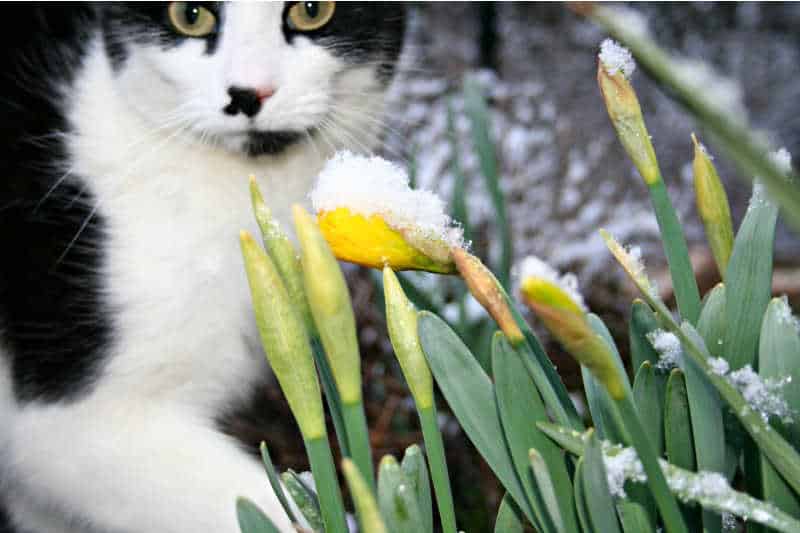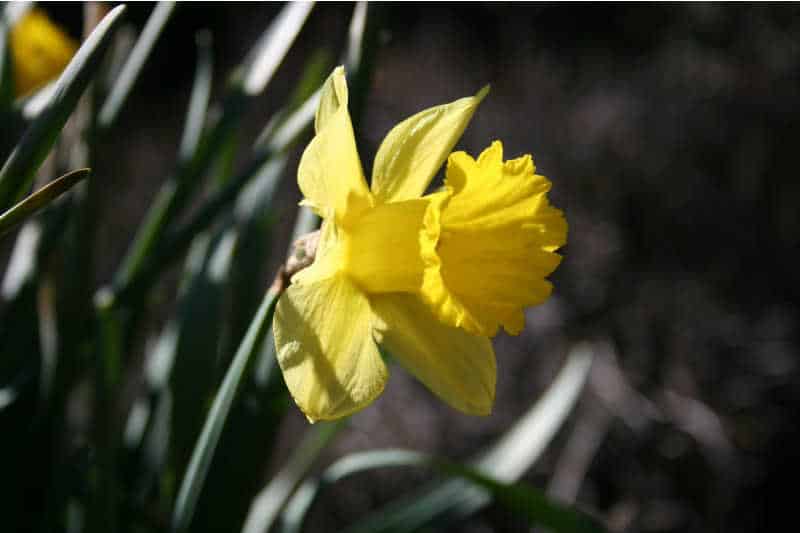Do you need to protect daffodils from the snow? How about from ice, cold or frost?
I think these pictures are worth a thousand words! We had a surprise little snow squall last night here in south central Virginia. Although not much is blooming in my garden, the crocus, snow drops and daffodils are already awake and blooming. There’s nothing I love quite so much as daffodils, and I have them planted throughout the orchard as well as in my flower garden. The daffodil above is in my flower garden, the perennial garden right next to the driveway.

When snow threatens, your first instinct as a gardener may be to run outside and cover up your plants to protect them from the snow. That’s a good instinct with tender annuals, vegetable plants and perennials. A late frost in the spring can kill heat-loving vegetables planted after your frost-free date. Although the frost-free date is fairly reliable, nature isn’t always predictable, and it can still mean a late frost. Tender perennials, annuals, and herb plants all need to be covered with newspaper, mulch of fabric — never plastic — in the event of a frost.
But what about daffodils? Do daffodils need protect from the snow? How about their springtime friends: crocus, tulips, snowdrops, hyacinth and myriad other spring blooming bulbs?
Do Daffodils Need Protection from Snow?
The short answer is generally, no. Most spring-blooming flowers are very resilient and hardy. They have to be. Anything that blooms in the spring may be subjected to snow, cold and wide swings in temperature.
Throughout the ages, natural selection took care of the weaker plants so that only the stronger ones survived and passed along their genes. The flower bulbs in your garden today descended from strong, hardy plants, and can withstand cold better than you think.
Of course, it’s better that they have some insulation. Believe it or not, snow acts as insulation, so I wasn’t too worried about my daffodils. A little snow with a touch of ice crystals on top won’t hurt them.
If the snow cover is prolonged, or the temperatures drop into the lower 20s, however, the plants may not survive.
Temporary Frost Protection: Use a Sheet or Blanket
If you need to temporarily protect plants from frost, snow or ice, you can cover them at night with a sheet or a blanket. Do not leave the cover on them during the day. They need sunlight for photosynthesis. Place the sheet or blanket gently over the plants. You may need to weigh down the corners with rocks. Be sure to remove the blanket or sheet the next day. Shake off the ice or snow. Leave plants uncovered during the daytime.
Never use plastic to cover plants when you expect cold weather. Plastic contributes to frost damage by making the areas near the leaves colder. It also traps moisture, which can freeze on the leaves and cause damage, and it isn’t good insulation.
Plant Leaves or Flowers Can Turn Brown from the Cold
Daffodils that are already blooming and are hit with cold, frost, ice or very cold temperatures may lose their flowers. The tips of the leaves may turn brown. The flowers may droop, wilt or turn brown. This does not harm the plant but does end the flowering abruptly for the plant.

If You Can’t Cover the Flowers…
If you can’t cover the flowers and it’s going to get really cold or remain below freezing for several days, your best bet is to snap the flowers off at the stem and bring them inside to enjoy. Remember that daffodil sap will harm other flowers in the same vase, so don’t mix a daffodils with other flowers. Enjoy a bouquet by itself and keep that vase especially for your daffodils.
The next day, the green leaves may look a bit frost-nipped, but the plant will be fine. Frost-nipped leaves turn brown at the tips. The daffodil bulb, where next year’s flowers are made, sleeps underneath the soil, and it won’t be harmed by the cold.






We are expecting about 2 inches of snow here in Buffalo, NY. I was wondering if I should cover my Easter Lilies. They are only about a inch tall. Thank you!
Cathy, I would cover Easter Lilies with some mulch, newspaper or blankets overnight or while there is snow. Mulch is probably best. Uncover them again when the snow melts. Good luck!
Thank you!!!
As I anticipate temps in the 20s tonight after weeks of 70 s and lows in the 50s, I am hopeful my blooming daffodils will make it through the freeze! Thanks!
They may look a little browned around the edges tomorrow from frost, but they should survive. Enjoy and thanks for leaving the comment!
We are expecting 1/2″ of ice in the next 24 hrs here in Buffalo, NY. My daffodils are up but have not yet bloomed. Should I cover them?
If you can cover them with paper (newspaper, etc) I would. If you can’t cover them, they may turn brown or you may lose this year’s blooms but they should return in future years.